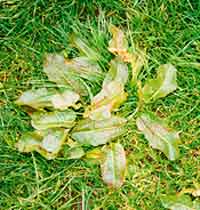Hold off dock spray until weeds recover from freeze

Farmers should be prepared to delay dock spraying by up to three weeks as cold weather may have stunted growth, reducing herbicide uptake, according to Duncan Connabeer, technical support manager for H L Hutchinson.
“Docks may have traditionally been sprayed at the end of March, but because cold weather has stunted growth in most regions, docks are not ready.”
David Roberts, grassland technical manager for Dow AgroSciences, says the dock spray window may be delayed by as much as four weeks in some areas of the country. “And the recent extreme cold weather in the north could delay this even further.”
Weeds should be sprayed at the right time, rather than by the calendar, to get the best results, says Mr Connabeer. “Although dock plants may appear large enough, cold damage may mean they are not at the correct stage for spraying (see picture, above).” Reddening of the leaves indicates the plant has been cold stressed and herbicide uptake will be poor.
“Any weeds must be actively growing for treatments to be successful,” stresses Mr Connabeer.
“It is worth delaying dock control; when plants are sprayed too early, decreased product translocation will reduce long-term control.” And because plants are not big enough, short-term control may also be compromised.
And considering a 10% infestation of docks will cause a 10% loss of grass – equating to one trailer load of silage in 10, effective control is essential. “Spraying docks too early is a waste of time and money,” says Mr Connabeer. “It is important to delay spraying accordingly, but leave enough time before first-cut silage.”
This later treatment may effect product selection this year, he says. “When farmers are looking for a quick knock back on weeds before silage cutting, they will need to select a product with faster kill rates.”
However, it is important to observe product labels to ensure the correct cutting interval is observed and make sure application is within environmental guidelines.
But, when grass has not had a chance to get going because of the poor winter and early spring, it is essential not to knock it back even further, warns Mr Roberts. “Traditional, phenoxy-based products are known to be more harsh on grass and should be avoided.
“When swards are slow growing and a silage cutting date is approaching, spraying with a grass harsh chemical will reduce yields.” The problem is likely to be exasperated this year as grass has already got off to a poor start.
But for other weeds traditionally treated early in the season, spraying should not be delayed, Mr Connabeer continues. “Ragwort, buttercups and scotch thistles are ready to be sprayed now. It is important to go in as soon as possible as you do not want poisonous plants, such as ragwort, present in cutting or grazing leys.” And considering it takes four-six weeks to kill Ragwort, it is essential to start control as soon as possible.
However, organic farmers who cultivated land under frosty conditions may see good dock control this year. “When dock plants are dragged to the surface in cold weather, the cold temperatures will penetrate the roots and may have helped reduce dock numbers.” But this will only be seen when conditions were right.
